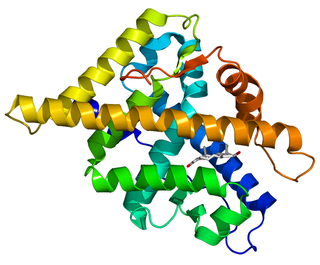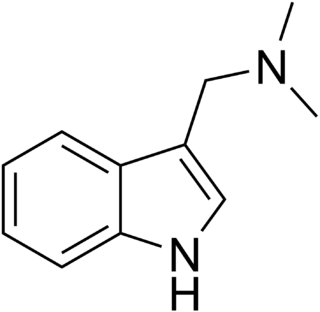
The epidermal growth factor receptor is a transmembrane protein that is a receptor for members of the epidermal growth factor family of extracellular protein ligands.

The androgen receptor (AR), also known as NR3C4, is a type of nuclear receptor that is activated by binding any of the androgenic hormones, including testosterone and dihydrotestosterone in the cytoplasm and then translocating into the nucleus. The androgen receptor is most closely related to the progesterone receptor, and progestins in higher dosages can block the androgen receptor.

Gramine is a naturally occurring indole alkaloid present in several plant species. Gramine may play a defensive role in these plants, since it is toxic to many organisms.

Parthenolide is a sesquiterpene lactone of the germacranolide class which occurs naturally in the plant feverfew, after which it is named, and in the closely related tansy. It is found in highest concentration in the flowers and fruit. Parthenolide's molecular structure depiction is often incorrect regarding the stereochemistry of the epoxide, although X-ray single crystal structures are available.

Tropomyosin receptor kinase B (TrkB), also known as tyrosine receptor kinase B, or BDNF/NT-3 growth factors receptor or neurotrophic tyrosine kinase, receptor, type 2 is a protein that in humans is encoded by the NTRK2 gene. TrkB is a receptor for brain-derived neurotrophic factor (BDNF). Standard pronunciation is "track bee".
The liver X receptor (LXR) is a member of the nuclear receptor family of transcription factors and is closely related to nuclear receptors such as the PPARs, FXR and RXR. Liver X receptors (LXRs) are important regulators of cholesterol, fatty acid, and glucose homeostasis. LXRs were earlier classified as orphan nuclear receptors, however, upon discovery of endogenous oxysterols as ligands they were subsequently deorphanized.

Honokiol is a lignan isolated from the bark, seed cones, and leaves of trees belonging to the genus Magnolia. It has been identified as one of the chemical compounds in some traditional eastern herbal medicines along with magnolol, 4-O-methylhonokiol, and obovatol.

Toll-like receptor 4 is a protein that in humans is encoded by the TLR4 gene. TLR4 is a transmembrane protein, member of the toll-like receptor family, which belongs to the pattern recognition receptor (PRR) family. Its activation leads to an intracellular signaling pathway NF-κB and inflammatory cytokine production which is responsible for activating the innate immune system.

Matairesinol is an organic compound. It is classified as a lignan, i.e., a type of phenylpropanoid. It is present in some cereals, e.g. rye, and together with Secoisolariciresinol, has attracted much attention for its beneficial nutritional effects.

Peroxisome proliferator- activated receptor gamma, also known as the glitazone reverse insulin resistance receptor, or NR1C3 is a type II nuclear receptor that in humans is encoded by the PPARG gene.

Adiponectin receptor 1 (AdipoR1) is a protein which in humans is encoded by the ADIPOR1 gene. It is a member of the progestin and adipoQ receptor (PAQR) family, and is also known as PAQR1.

Arctiin is a lignan found in many plants of the family Asteraceae, particularly the greater burdock and Centaurea imperialis, and in Trachelospermum asiaticum, Saussurea heteromalla, and Forsythia viridissima. It is the glucoside of arctigenin.

Discoidin domain-containing receptor 2, also known as CD167b, is a protein that in humans is encoded by the DDR2 gene. Discoidin domain-containing receptor 2 is a receptor tyrosine kinase (RTK).

BAY 60–6583 is a selective adenosine A2B receptor agonist. It has been shown to provide protection from ischemia in both the heart and kidney of test animals, and has also been shown to be beneficial in treatment of acute lung and brain injury, as well as claimed anti-aging and anti-obesity effects, showing a range of potential applications for selective A2B agonists.

Adiponectin receptor 2 (AdipoR2) is a protein which in humans is encoded by the ADIPOR2 gene. It is a member of the progestin and adipoQ receptor (PAQR) family, and is also known as PAQR2.

Taxifolin (5,7,3',4'-flavan-on-ol), also known as dihydroquercetin, belongs to the subclass flavanonols in the flavonoids, which in turn is a class of polyphenols.

In molecular biology mir-22 microRNA is a short RNA molecule. MicroRNAs are an abundant class of molecules, approximately 22 nucleotides in length, which can post-transcriptionally regulate gene expression by binding to the 3' UTR of mRNAs expressed in a cell.
Menerba, also known as Menopause Formula 101 (MF-101), is a botanical drug candidate that acts as a selective estrogen receptor modulator (SERM) which is being studied for its potential to relieve hot flashes associated with menopause. Menerba, an estrogen receptor beta (ERβ) agonist (ERBA), is part of a new class of receptor subtype-selective estrogens, which is selective in transcriptional regulation to one of the two known estrogen receptor (ER) subtypes. Menerba consists of 22 herbs that have been used historically in traditional Chinese medicine.

Deoxyschizandrin is a bio-active isolate of Schisandra chinensis.

Tropoflavin, also known as 7,8-dihydroxyflavone, is a naturally occurring flavone found in Godmania aesculifolia, Tridax procumbens, and primula tree leaves. It has been found to act as a potent and selective small-molecule agonist of the tropomyosin receptor kinase B (TrkB), the main signaling receptor of the neurotrophin brain-derived neurotrophic factor (BDNF). Tropoflavin is both orally bioavailable and able to penetrate the blood–brain barrier. A prodrug of tropoflavin with greatly improved potency and pharmacokinetics, R13, is under development for the treatment of Alzheimer's disease.


















